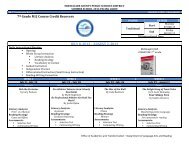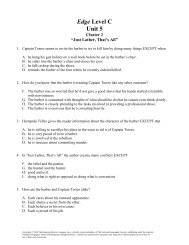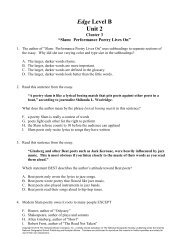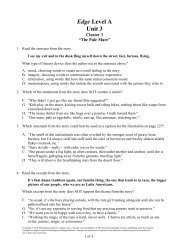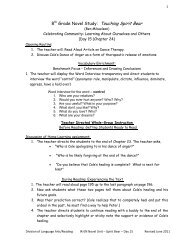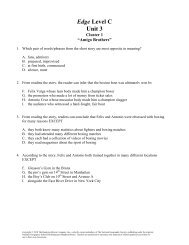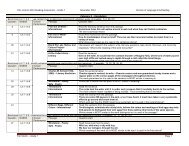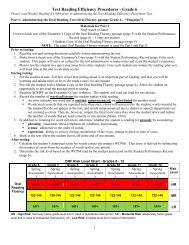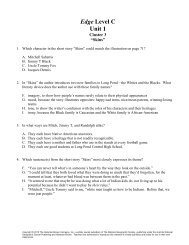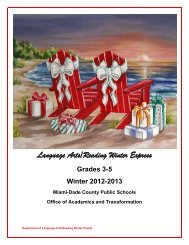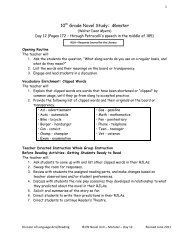Tops & Bottoms - Division of Language Arts/Reading
Tops & Bottoms - Division of Language Arts/Reading
Tops & Bottoms - Division of Language Arts/Reading
- No tags were found...
You also want an ePaper? Increase the reach of your titles
YUMPU automatically turns print PDFs into web optimized ePapers that Google loves.
Review <strong>Tops</strong> and <strong>Bottoms</strong>for Text ComplexityQualitative EvaluationCategoryStructure(both story structure or form <strong>of</strong> piece)<strong>Language</strong> Demands andConventions(including vocabulary load andsentence structure)Knowledge Demands(life, content, cultural/literary )Levels <strong>of</strong> Meaning/PurposeNotes and Comments on TextBook opens top to bottomOnce upon a time (story)SequentialCausal and Problem SolutionVocabulary load (business partners,pr<strong>of</strong>it, debt, wealth,)Sentence Structure (dialogue, sentencevariety)Using dashes in the middle <strong>of</strong> sentencesBackground Knowledge about(harvesting, crops, business partnershipsand alluding to the fable “Tortoise andthe Hare”Literal: Hare, who is hungry, plants on bearsland, so he and his family have food to eat.Inferential: While Hare is doing all thework, Bear is being tricked.Analytical: Bears realization <strong>of</strong> Hare’strickery leads him to learning a lesson;Hard work pays <strong>of</strong>f.
Visualizing Planning andInstructionPlanningTeachingOverarching QuestionRight There/LiteralAuthor and You/Analytical QuestionsThink and SearchAuthor and You/Think and Search/InferenceAuthor and You/Think and Search/InferenceAuthor and You/Think and Search/InferenceAuthor and You/Think and Search/InferenceThink and SearchAuthor and You/Analytical QuestionsRight There/LiteralOverarching Question
Text Title: __________________Instructional GuideText Structure: ________________ Genre: ________________Planning for InstructionIdentify Core UnderstandingandKey Ideas <strong>of</strong> the Text(Identify the key insights studentsshould understand from the text.)Identify theliterary/informationalstandards for instructionLiteral:Inferential:Analytical:Instructional ToolsCulminating Assessment(Performance Task)Coherent sequences <strong>of</strong>Text Dependent Questions(Create coherent questions <strong>of</strong> textdependent literal, inferential, andanalytical questions.)Identify/Clarify AcademicVocabulary and Text Structure(Locate text structure and mostpowerful academic words that areconnected to key ideas.)Identify/Clarify SentencesyntaxFoundational SkillsPhonics High Frequency Words Conventions<strong>Language</strong>
Key IdeasIdentify CoreUnderstandingandKey Ideas <strong>of</strong>the Text(Identify the keyinsights studentsshould understandfrom the text.)Literal• Hare, who is hungry, plants onbears land, so he and hisfamily have food to eat.Inferential• While Hare is doing all thework, Bear is being tricked.Analytical• Bears realization <strong>of</strong> Hare’strickeryLeads him to learning a lesson;Hard work pays <strong>of</strong>f.Instructional Tools:•Mentor Text
StandardsIdentify theliterary/informationa/Listening andspeakingstandards forinstructionRL.2.2 – Recount stories, including fables and folktales from diversecultures, and determine their central message, or moral.RL.2.3 – Describe how characters in a story respond to major eventsand challenges.RL.2.10 – By the end <strong>of</strong> the year, read and comprehend literature,including stories and poetry, in the grades 2-3 text complexity bandpr<strong>of</strong>iciently , with scaffolding as needed at the high end <strong>of</strong> the range.RL.2.1- Ask and answer such questions as who, what , where, when, whyand how, to demonstrated understanding <strong>of</strong> key details in a text.RL.2.4 - Describe how words and phrases (e.g., regular beats,alliteration, rhymes, repeated lines) supply rhythm and meaning in astory, poem, or song.RL. 2.5 – Describe the overall structure <strong>of</strong> the story, including describinghow the beginning introduces the story and the ending concludes theaction.RL.2.6 – Acknowledge differences in the points <strong>of</strong> view <strong>of</strong> characters,including by speaking in a different voice for each character when readingdialogue aloud.RL. 2.7 – Use information gained from the illustration and words in aprint or digital text to demonstrate understanding <strong>of</strong> it’s characters,setting , or plot.Instructional Tools:•Common Core StateStandards Document•Mentor Text•Elements <strong>of</strong> aTrickster Tale•Trickster Tale Chart•Character TraitsChart•Bringing a Characterto Life•Text Coding•Context Clues Chart•Sentence SyntaxClarification Chart•VocabularyClarification Chart•Word Jars•Quick Writes
Performance Task QuestionPerformanceTask(CulminatingAssessment)• How do theevents in thestory changeBear’s workhabits?Instructional Tools:• QAR’s•Task Cards
Text Dependent QuestionsCoherentsequences <strong>of</strong>TextDependentQuestions(Create coherentquestions <strong>of</strong> textdependent literal,inferential, and analyticalquestions.)• What was Hare’s serious problem?• Did he go about getting food in theway that you would expect him to?• What makes a person clever?• How was Hare clever in the wayhe solved his problem?• When Hare tricks Bear for the firsttime, how does Bear feel? How doyou know?• Look at the illustrations on pages1-25, and describe how Bear feelsabout work. How do you know?• What do the illustration on pages26-29 show the reader aboutBear?Instructional Tools:•Task Cards•QAR’s•Mentor Text
VocabularyIdentify/ClarifyAcademicVocabularyand TextStructureThroughQuestioning(Locate textstructure andmost powerfulacademicwords that areconnected tokey ideas)AcademicVocabularywealthdebtpr<strong>of</strong>itbusinesspartnerscheatedcleverlazycropsharvestStory Structure•Book opens topto bottom•Once upon a time(story)•Sequential•Cause and Effect(Causal Incidents)•Problem SolutionInstructional Tools:•VocabularyClarification Chart•Context Clues Chart•Reader’s ResponseLog•Mentor Text
Sentence SyntaxIdentify/ClarifySentencesyntaxSentencestructuremattersbecause itdetermineshow the wordsoperatetogether andhow the ideasexpressed bythese wordsall fit togetherSo Hare and Mrs. Hare put their headstogether and cooked up a plan.“The top half or the bottom half? It’s up toyou -tops or bottoms.”“It’s a done deal, Bear.”When it was time for the harvest..We can split the pr<strong>of</strong>it right down themiddle.And although Hare and Bear learned to livehappily as neighbors, they never becamebusiness partners again.Instructional Tools:•Sentence SyntaxClarification Chart•Reader’s ResponseLog•Mentor Text
Close Analytic Read Activity Read the story Think about what is the most importantlearning to be drawn from the text. (key idea(s)) Develop an over arching question thataddresses the key idea(s). Create a series <strong>of</strong> sequential questions thatare always evidenced in the text to bring thereader to an understanding <strong>of</strong> the overarching question or performance task.
Close Analytic ReadRules <strong>of</strong> the Road The text is the expert – not the teacher Foster student confidence and independence byhaving students reread the passage, consultillustrations. Student support is in pairs, small groups and wholeclass settings. Structure and time for collaboration, discussing andprocessing help students internalize the skill. Goal is total understanding <strong>of</strong> text. Don’t rush through – have patience with a slowerlearning process that is required by the standards andformat <strong>of</strong> instruction. (close analytic reading)
Close Analytic ReadRules <strong>of</strong> the Road In primary grades, Read Alouds are expected. Front-loading should be done judiciously. The content should be embedded both in thetext and illuminated by the discussion questions,writing activities, and extension activities. Selected text should enhance student literacy– based exercises and allow them to practiceanalyzing content based themes.
Close Analytic ReadRules <strong>of</strong> the RoadClose analytic reading <strong>of</strong> exemplar text should include: Learning Objectives – 4-5 days on an exemplar text <strong>Reading</strong> Tasks – independence is the goal through multipleencounters with the text, carefully planned andsequenced questioning with answers that are alwaysevidenced in text. Discussion/<strong>Language</strong>/Vocabulary Tasks – activities thatencourage discussion, inferring meaning from context, andattention to academic language. High value words shouldbe discussed and lingered over during the instructionalsequence.
Close Analytic ReadRules <strong>of</strong> the RoadClose analytic read should include: Sentence Syntax Tasks – Engage students in a close examination<strong>of</strong> complex sentences to discover how they are built and howthey convey meaning. Unpacking complex text focuses on boththe precise meaning <strong>of</strong> what the author is saying and why theauthor might have constructed the sentence in a particularfashion. Writing Tasks – Students may paraphrase, synthesize ideas,support opinions, or explain relationships in a culminationactivity to organize and make sense <strong>of</strong> their thinking andlearning.
Creating Text-Dependent Questions forClose Analytic <strong>Reading</strong> <strong>of</strong> Texts Step One: Identify the core Understandings and Key Ideas <strong>of</strong> the Text Step Two: Start Small to Build Confidence Step Three: Target Vocabulary and Text Structure Step Four: Tackle Tough Section Head On Step Five: Create Coherent Sequences <strong>of</strong> Text Dependent Questions Step Six: Identify the Standards being Addressed Step Seven: Create the Culminating Assessment
Question-AnswerRelationships
Literal: Hare, who is hungry, plants on bearsland, so he and his family have food to eat.
FIVE DAY PLAN FOR“TOPS AND BOTTOMS”
Five Day PlannerDay 1 Day 2 Day 3 Day 4 Day 5Focus Standard: Focus Standard: Focus Standard:Vocabulary/Sent. Syn. Story Structure Interaction/Point <strong>of</strong> ViewFocus Standard:Main Idea• Characteristics <strong>of</strong> aTrickster Tale• Cover to CoverPurpose setting:Student read the textindependently for initialunderstanding .• Students will orallyrecount and describekey ideas or detailsfrom the text. Teacherwill ask buildingconfidence questions•Students in smallgroups participate incollaborativeconversationsto complete theElements <strong>of</strong> a TricksterTale Chart.• Teach contextclues utilizing the“Context CluesChart”Purpose setting:Reread to clarifywords and/or phrasesin text.• Teacher will guideand facilitate theacademicvocabulary andsentence syntaxdiscussions• Students willcomplete theVocabulary andSentence SyntaxClarification Charts• Teach literary textstructurePurpose Setting:Reread to sequentiallyorganize major eventin the story.• Students willcomplete thepattern puzzlein small groups• Students recountthe story using theirpattern puzzle• Students completethe story map• Ask and answerstory structurequestions,• Quick Write inresponse log• Character traitslessonPurpose Setting:Students willreread the text insmall groups to findevidence <strong>of</strong>character traits forthe assignedcharacter and textmark.• Students willcomplete theAuthor’s Toolbox forBringing a Characterto Life Chart in smallgroups• Ask and answerquestions related tocharacterdevelopmentFocus Standard:Cmplx.Text/M.I./Intrctn• Ask and answerCoherentSequence <strong>of</strong> TextDependentQuestionsPurpose Setting:Pose the PerformanceTask Question• Reread and answerthe PerformanceTask Question• Follow thePerformance TaskInstructionalProcedureFoundational SkillsFoundational SkillsFoundational SkillsFoundational SkillsFoundational Skills
Five Day PlannerDay 1 Day 2 Day 3 Day 4 Day 5Focus Standard:Main Idea• Characteristics <strong>of</strong> aTrickster Tale• Cover to CoverPurpose setting:Student read the textindependently for initialunderstanding .• Students will orallyrecount and describekey ideas or detailsfrom the text. Teacherwill ask buildingconfidence questions•Students in smallgroups participate incollaborativeconversationsto complete theElements <strong>of</strong> a TricksterTale Chart.Foundational Skills
Trickster TalesELEMENTS OF A TRICKSTER TALEThere are several elements that a Trickster Tale must have:‣ A clever animal or person who plays a trick on othercharacters.‣ One <strong>of</strong> the characters has a problem to solve.‣ The trickster has one or two main characteristics, suchas greediness or boastfulness.‣ The language sounds as if someone were telling thetale out loud.‣ The plot moves fast and the ending comes quickly.‣ There is a moral or lesson to learn.
Five Day PlannerDay 1 Day 2 Day 3 Day 4 Day 5Focus Standard: Focus Standard:Main Idea Vocabulary/Sent. Syn.• Characteristics <strong>of</strong> aTrickster Tale• Cover to CoverPurpose setting:Student read the textindependently for initialunderstanding .• Students will orallyrecount and describekey ideas or detailsfrom the text. Teacherwill ask buildingconfidence questions•Students in smallgroups participate incollaborativeconversationsto complete theElements <strong>of</strong> a TricksterTale Chart.• Teach contextclues utilizing the“Context CluesChart”Purpose setting:Reread to clarifywords and/or phrasesin text.• Teacher will guideand facilitate theacademicvocabulary andsentence syntaxdiscussions• Students willcomplete theVocabulary andSentence SyntaxClarification ChartsFoundational SkillsFoundational Skills
Activities that encourage discussion, inferring meaningfrom context and attention to academic languageand examination <strong>of</strong> complex sentences should belingered over during the instructional sequence.Academic Vocabularywealth (page 1)lazy (page 1)debt (page 2)pr<strong>of</strong>it (page 5)business partners (page 5)cheated (page 20)clever (page 2)crops (page 8)harvest (page 9)Sentence SyntaxSo Hare and Mrs. Hare put their headstogether and cooked up a plan.“The top half or the bottom half? It’s up toyou -tops or bottoms.”“It’s a done deal, Bear.”When it was time for the harvest..We can split the pr<strong>of</strong>it right down themiddle.And although Hare and Bear learned tolive happily as neighbors, they neverbecame business partners again.
Organizing the Thinking andLearningSo Hare and Mrs. Hareput their heads togetherand cooked up a plan.“It’s a done deal, Bear.”They're thinking <strong>of</strong> somethingto do so that their children arenot hungry.The phrase “cooked up aplan” means that, there wasmischief and trickeryinvolved.wealthlots <strong>of</strong> moneyand lots <strong>of</strong>landa large amount <strong>of</strong>money or possessionsrichlazy
Academic Vocabulary andSentence Syntax QuestionsAcademic VocabularyRead these sentences from thepassage.Sentence SyntaxWhat does the author meanwhen she writes so Hare andMrs. Hare puts their headstogether and cooked up a plan?Once upon a time there lived a verylazy Bear who had lots <strong>of</strong> money andlots <strong>of</strong> land. His father had been ahard worker and a smart businessbear, and he had given all <strong>of</strong> hiswealth to his son.What does the word wealth mean?
Five Day PlannerDay 1 Day 2 Day 3 Day 4 Day 5Focus Standard: Focus Standard: Focus Standard:Main Idea Vocabulary/Sent. Syn. Story Structure• Characteristics <strong>of</strong> aTrickster Tale• Cover to CoverPurpose setting:Student read the textindependently for initialunderstanding .• Students will orallyrecount and describekey ideas or detailsfrom the text. Teacherwill ask buildingconfidence questions•Students in smallgroups participate incollaborativeconversationsto complete theElements <strong>of</strong> a TricksterTale Chart.• Teach contextclues utilizing the“Context CluesChart”Purpose setting:Reread to clarifywords and/or phrasesin text.• Teacher will guideand facilitate theacademicvocabulary andsentence syntaxdiscussions• Students willcomplete theVocabulary andSentence SyntaxClarification Charts• Teach literary textstructurePurpose Setting:Reread to sequentiallyorganize major eventin the story.• Students willcomplete thepattern puzzlein small groups• Students recountthe story using theirpattern puzzle• Students completethe story map• Ask and answerstory structurequestions,• Quick Write inresponse logFoundational SkillsFoundational SkillsFoundational Skills
Day 3 ActivitiesText Structure Book opens top to bottom Once upon a time (story) Sequential Cause and Effect(Causal Incidents) Problem Solution
Day 3 Activities• What problem does Harehave?• Where does the story takeplace? How do you know?• When Hare tricks Bear forthe first time, how doesBear feel? How do youknow?• Look at the illustration onpages 1-25, describeBear’s attitude about work.• What do the illustrations onpages 26-29 show thereader about Bear?• What lesson has Bearlearned?
Five Day PlannerDay 1 Day 2 Day 3 Day 4 Day 5Focus Standard: Focus Standard: Focus Standard: Focus Standard:Main Idea Vocabulary/Sent. Syn. Story Structure Interaction/Point <strong>of</strong> View• Characteristics <strong>of</strong> aTrickster Tale• Cover to CoverPurpose setting:Student read the textindependently for initialunderstanding .• Students will orallyrecount and describekey ideas or detailsfrom the text. Teacherwill ask buildingconfidence questions•Students in smallgroups participate incollaborativeconversationsto complete theElements <strong>of</strong> a TricksterTale Chart.• Teach contextclues utilizing the“Context CluesChart”Purpose setting:Reread to clarifywords and/or phrasesin text.• Teacher will guideand facilitate theacademicvocabulary andsentence syntaxdiscussions• Students willcomplete theVocabulary andSentence SyntaxClarification Charts• Teach literary textstructurePurpose Setting:Reread to sequentiallyorganize major eventin the story.• Students willcomplete thepattern puzzlein small groups• Students recountthe story using theirpattern puzzle• Students completethe story map• Ask and answerstory structurequestions,• Quick Write inresponse log• Character traitslessonPurpose Setting:Students willreread the text insmall groups to findevidence <strong>of</strong>character traits forthe assignedcharacter and textmark.• Students willcomplete theAuthor’s Toolbox forBringing a Characterto Life Chart in smallgroups• Ask and answerquestions related tocharacterdevelopmentFoundational SkillsFoundational SkillsFoundational SkillsFoundational Skills
Text Coding/Selective Highlighting Helps to understand the importance <strong>of</strong> key ideaswithin a piece <strong>of</strong> text Extends text discussion Dictated by the essential question and/or thetheme to help to set the purpose for readingH– Evidence <strong>of</strong> what Hare says, does, andhow he is depicted in the illustrations.B - Evidence <strong>of</strong> what Bear says, does, andhow he is depicted in the illustrations.
Everyday Iteachlessons thatare handson(action)lively,talented,skillful,wiseKeep yourvoices down.Stand in astraight lineand walk thehallwayquietlydutiful,leader,strict
All hedoes issleeplazy,carelessOne Sentence Summary_________ is ________ because _________.
Day 4 ActivitiesCharacter TraitsActiveCleverSneakySlySkillfulRichWickedWiseLazyGrumpyJealous
Coherent Sequence <strong>of</strong> TextDependent QuestionsWhat was Hare’s serious problem?Did he go about getting food in the way that you would expect himto?What makes a person clever?How was Hare clever in the way he solved his problem?When Hare tricks Bear for the first time, how does Bear feel? How doyou know?Look at the illustrations on pages 1-25, and describe how Bear feelsabout work. How do you know?What do the illustration on pages 26-29 show the reader aboutBear?
Culminating ActivityPerformance Task Question‣How do the events inthe story change Bear’swork habits?
Performance TaskInstructional ProcedureTeacher Modeling/Think Aloud• Teacher/student analyze question by discussing what is necessary to fulfill the requirement<strong>of</strong> the task• Teacher/students examine text to support the responsesWrite Answers To The Questions• Students write individual answers• Students share written responses in pairs/groupsImproving ResponsesCompare and Justify• Guide students in discussing whether the answer fulfills the reading concepts embodied inthe task and are supported by the selectionDevelop Better Responses• Use student responses to build and model complete paraphrased text-based answersApplication For Ongoing Instruction• Students practice responding to similar questions and apply strategies independently withvarious texts• Teachers select assessments for primary and secondary standards
Foundational SkillsInstruction <strong>of</strong> FoundationalSkills Utilizing <strong>Tops</strong> and <strong>Bottoms</strong>COMMON SPELLING SOUNDCORRESPONDANCE
Foundational SkillsInstruction <strong>of</strong> FoundationalSkills through an Exemplar Text Review any previously taughtfoundational skills utilizing the exemplartext (if the text lends itself to theinstruction) Identify additional foundational skillsstandards that could be instructed andaddressed using the exemplar text
Five Day PlannerDay 1 Day 2 Day 3 Day 4 Day 5Focus Standard: Focus Standard: Focus Standard:Vocabulary/Sent. Syn. Story Structure Interaction/Point <strong>of</strong> ViewFocus Standard:Main Idea• Characteristics <strong>of</strong> aTrickster Tale• Cover to CoverPurpose setting:Student read the textindependently for initialunderstanding .• Students will orallyrecount and describekey ideas or detailsfrom the text. Teacherwill ask buildingconfidence questions•Students in smallgroups participate incollaborativeconversationsto complete theElements <strong>of</strong> a TricksterTale Chart.• Teach contextclues utilizing the“Context CluesChart”Purpose setting:Reread to clarifywords and/or phrasesin text.• Teacher will guideand facilitate theacademicvocabulary andsentence syntaxdiscussions• Students willcomplete theVocabulary andSentence SyntaxClarification Charts• Teach literary textstructurePurpose Setting:Reread to sequentiallyorganize major eventin the story.• Students willcomplete thepattern puzzlein small groups• Students recountthe story using theirpattern puzzle• Students completethe story map• Ask and answerstory structurequestions,• Quick Write inresponse log• Character traitslessonPurpose Setting:Students willreread the text insmall groups to findevidence <strong>of</strong>character traits forthe assignedcharacter and textmark.• Students willcomplete theAuthor’s Toolbox forBringing a Characterto Life Chart in smallgroups• Ask and answerquestions related tocharacterdevelopmentFocus Standard:Cmplx.Text/M.I./Intrctn• Ask and answerCoherentSequence <strong>of</strong> TextDependentQuestionsPurpose Setting:Pose the PerformanceTask Question• Reread and answerthe PerformanceTask Question• Follow thePerformance TaskInstructionalProcedure• Instruction <strong>of</strong> theee vowel team• HFW• Making WordsLesson• HFW• Syllable PatternsFoundational Lesson Skills• HFW• Spot and DotFoundational for Syllabication Skills• HFW• Assess PhonicFoundational Skill <strong>of</strong> the SkillsWeek
Foundational SkillsRF.2.3b-Know spelling-soundcorrespondences for commonvowel teamsRF.2.3c –Decode regularly spelled twosyllablewords with longvowelssleepasleepweededbeetsagreedhungryneighboropenweededseasoncheated
RF.2.3b Know spelling-soundcorrespondences for commonvowel teamsMaking Words Lesson: eeLetters: e e n p r s tsee seep seen teen tree trees steer steep spree presentMake Words:1. Take 2 letters and make see.2. Add a letter to see and spell seep.3. Change the last letter and you spell seen.4. Change the first letter and you can spell teen.5. Let’s spell one more 4-letter word, tree.6. Add a letter and you can spell trees.7. Move the letters in trees around and you can spell steer.8. Change the last letter and you can spell steep.9. Remove the letter t, add another letter and you can spell spree.10.It’s time for the secret word, and it is a hard one. I will give you someclues if you need them. (Start your word with the p. Put the s in themiddle and the t at the end. You might get one on your birthday.(Present)eeseeseepseenteentreesteersteepspreesleepasleepweededbeetsagreed
Six Syllable PatternsSyllable Type Example % Frequency<strong>of</strong>OccurrenceClosed fantastic 43.3Open silent 28.9VCe basement 6.7Vowel team(diphthongs)r-controlledmoisture 9.5circumstanceFoundational Skills10.2Final Stable station 1.4
Foundational SkillsSyllable <strong>Division</strong> PatternsVC/CVV/CVVC/VVC/CCVbas/ketfu/turesev/enen/tryVC/CCCVcon/structV/Vli/on68
“SPOT AND DOT”Strategy for Syllabication• “Spot and dot” the vowels• Connect the dots• Look at the number <strong>of</strong> consonants betweenthe vowels• If 3 or 4 – break after the first consonant• If 2 – break between the consonants• If 1 – break before the consonant, if itdoesn’t sound right, move over one letter• If 2 vowels break between vowels
Foundational Skillshungryclosedneighboropenweededseasonopen (long)vowel team (long) vowel –ropen (long)vowel team (long)vowel team (long)closedcheatedvowel team (long)final stableclosedfinal stable
Foundational SkillsHigh Frequency WordsThings to Consider A-Z Word Wall (Continually Evolving) Daily Interactive Activities (Multiple Exposure) Automaticity in the recognition <strong>of</strong> thesewords in connected text
Foundational SkillsPurposefulCollections/Jarsword familiesA-Z Word Walls- highfrequency words;phonics patternshighlightedInteractive HFWConcentrationGame (FCRR Act.)Interactive HFWCheckerboardGame (FCRR Act.)
COMMON CORE STATESTANDARDSTOPS AND BOTTOMSSECOND GRADE EXEMPLARLESSON
Trickster TalesELEMENTS OF A TRICKSTER TALEThere are several elements that a Trickster Tale must have:‣ A clever animal or person who plays a trick onother characters.‣ One <strong>of</strong> the characters has a problem to solve.‣ The trickster has one or two main characteristics,such as greediness or boastfulness.‣ The language sounds as if someone were tellingthe tale out loud.‣ The plot moves fast and the ending comesquickly.‣ There is a moral or lesson to learn.
Cover To CoverLet’s look at the front cover <strong>of</strong> thebook and the back cover <strong>of</strong> thebook.What do you see?How do these illustrations makeyou feel or think about?
Cover To Cover
Literal: Hare, who is hungry, plants on bearsland, so he and his family have food to eat.
LET’S RECOUNT ORALLY…..•What was Hare’s seriousproblem?•Where does Bear live?•What did Bear want to do all daylong?•What did Hare’s family do tohelp Hare?
Foundational SkillsRF.2.3b-Know spelling-soundcorrespondences for commonvowel teamsRF.2.3c –Decode regularly spelled twosyllablewords with longvowelssleepasleepweededbeetsagreedhungryneighboropenweededseasoncheated
RF.2.3b Know spelling-soundcorrespondences for commonvowel teamsMaking Words Lesson: eeLetters: e e n p r s tsee seep seen teen tree trees steer steep spree presentMake Words:1. Take 2 letters and make see.2. Add a letter to see and spell seep.3. Change the last letter and you spell seen.4. Change the first letter and you can spell teen.5. Let’s spell one more 4-letter word, tree.6. Add a letter and you can spell trees.7. Move the letters in trees around and you can spell steer.8. Change the last letter and you can spell steep.9. Remove the letter t, add another letter and you can spell spree.10.It’s time for the secret word, and it is a hard one. I will give you someclues if you need them. (Start your word with the p. Put the s in themiddle and the t at the end. You might get one on your birthday.(Present)eeseeseepseenteentreesteersteepspreesleepasleepweededbeetsagreed
Look For These Words as You Read…..wealth (page 1)business partners(page 5)debt (page 2) crops (page 8)clever (page 2) harvest (page 9)pr<strong>of</strong>it (page 5) cheated (page 20)
Look For These Phrases as You Read…..So Hare and Mrs. Hare put their heads togetherand cooked up a plan.“The top half or the bottom half? It’s up to you -tops or bottoms.”“It’s a done deal, Bear.”When it was time for the harvest..We can split the pr<strong>of</strong>it right down the middle.And although Hare and Bear learned to livehappily as neighbors, they never became businesspartners again.
So Hare and Mrs. Hare put their headstogether and cooked up a plan.They're thinking <strong>of</strong> something to do so that theirchildren are not hungry.The phrase “cooked up a plan” means that,there was mischief and trickery involved.“It’s a done deal, Bear.”
wealthlots <strong>of</strong> money and lots<strong>of</strong> landa large amount <strong>of</strong> money orpossessionsrichlazy
Academic VocabularySentence SyntaxRead these sentences from thepassage.Once upon a time there lived a verylazy Bear who had lots <strong>of</strong> money andlots <strong>of</strong> land. His father had been ahard worker and a smart businessbear, and he had given all <strong>of</strong> hiswealth to his son.What does the author meanwhen she writes so Hare andMrs. Hare puts their headstogether and cooked up a plan?What does the word wealth mean?
Text Structure Book opens top to bottom Once upon a time (story) Sequential Cause and Effect(Causal Incidents) Problem Solution
Complete the Pattern Puzzle….
Story Map• What problem does Harehave?• Where does the story takeplace? How do you know?• When Hare tricks Bear forthe first time, how doesBear feel? How do youknow?• Look at the illustration onpages 1-25, describeBear’s attitude about work.• What do the illustrations onpages 26-29 show thereader about Bear?• What lesson has Bearlearned?
Foundational SkillsSyllable <strong>Division</strong> PatternsVC/CVV/CVVC/VVC/CCVbas/ketfu/turesev/enen/tryVC/CCCVcon/structV/Vli/on40
Text Coding/Selective HighlightingH– Evidence <strong>of</strong> what Haresays, does, and how he isdepicted in the illustrations.B - Evidence <strong>of</strong> what Bearsays, does, and how he isdepicted in the illustrations.
Everyday Iteachlessons thatare handson(action)lively,talented,skillful,wiseKeep yourvoices down.Stand in astraight lineand walk thehallwayquietlydutiful,leader,strict
All hedoes issleeplazy,carelessOne Sentence Summary_________ is ________ because _________.
CharacterTraits
“SPOT AND DOT”Strategy for Syllabication• “Spot and dot” the vowels• Connect the dots• Look at the number <strong>of</strong> consonants betweenthe vowels• If 3 or 4 – break after the first consonant• If 2 – break between the consonants• If 1 – break before the consonant, if itdoesn’t sound right, move over one letter• If 2 vowels break between vowels
Foundational Skillshungryclosedneighboropenweededseasonopen (long)vowel team (long) vowel –ropen (long)vowel team (long)vowel team (long)closedcheatedvowel team (long)final stableclosedfinal stable
Culminating ActivityPerformance Task Question‣How do the events inthe story change Bear’swork habits?
GRADE: 2 CCSS AT-A-GLANCEREADING STANDARDS for LITERATUREKey Ideas & Details1.Ask and answer questions to demonstrate understanding <strong>of</strong> key detailsin a text.2.Recount stories and determine their central message, lesson, or moral.3.Describe how characters respond to major events and challenges.Craft & Structure4.Describe how words and phrases supply rhythm and meaning in text.5.Describe the overall structure <strong>of</strong> a story from introduction to concludingaction.6.Acknowledge differences in points <strong>of</strong> view <strong>of</strong> the characters.Integration <strong>of</strong> Knowledge & Ideas7.Use information from illustrations and text to demonstrateunderstanding <strong>of</strong> its characters, setting, or plot.8.N/A9.Compare/contrast two or more versions <strong>of</strong> the same story.Range <strong>of</strong> <strong>Reading</strong> and Text Complexity10. Read and comprehend stories and poetry <strong>of</strong> appropriate complexityfor grades 2-3, with scaffolding as needed.INFORMATIONAL TEXTKey Ideas & Details1.Ask and answer questions to demonstrate understanding <strong>of</strong> key detailsin a text.2.Identify main topic <strong>of</strong> a multi-paragraph text as well as the focus <strong>of</strong> aspecific paragraph within the text.3.Describe the connection between a series <strong>of</strong> historical events, scientificideas or concepts, or steps in technical procedures in a text.Craft & Structure4.Determine the meaning <strong>of</strong> words and phrases in a text relevant to agrade 2 topic or subject area.5.Know and use various text features (e.g., headings, tables <strong>of</strong> contents,glossaries, electronic menus, icons) to locate key facts or informationefficiently.6.Identify the main purpose <strong>of</strong> a text (e.g., what the author wants toanswer, explain, or describe).Integration <strong>of</strong> Knowledge and Ideas7. Explain how specific images contribute to and clarify a text.8. Describe how reasons support specific points the author makes in atext.9. Compare and contrast the most important points presented by twotexts on the same topic.Range <strong>of</strong> <strong>Reading</strong> and Level <strong>of</strong> Text Complexity10. Read and comprehend informational texts with appropriatecomplexity for grades 2-3, with scaffolding as needed.FOUNDATIONAL SKILLSPhonics & Word Recognition1. Know & apply grade-level phonics and word analysis skills.a.Distinguish long and short vowels when reading regularly spelledone-syllable words.b.Know common vowel teams.c.Decode regularly spelled two-syllable words with long words.d. Decode words with common prefixes and suffixes.e. Identify words with inconsistent but common spelling-soundcorrespondences.f. Recognize and read grade-appropriate irregularly spelled words.Fluency4. Read grade level text with sufficient accuracy and fluency to supportcomprehension.a. Read with purpose and understanding.WRITING STANDARDSText Types and Purposes1. Write opinion pieces introducing the topic, state an opinion, supplyreasons that support the opinion, use linking words (e.g., because,and, also) to connect opinion and reasons, and provide a concludingstatement or section.2. Write informative/explanatory texts introduce a topic, use facts anddefinitions to develop points, and providing a concluding statementor section.3. Write narratives recounting a well-elaborated event or shortsequence <strong>of</strong> events, including details to describe actions, thoughts,and feelings, using temporal words to signal event order, and providea sense <strong>of</strong> closure.Production and Distribution <strong>of</strong> Writing5. Focus on a topic and strengthen writing as needed by revising andediting.6. Use a variety <strong>of</strong> digital tools to produce and publish writing.Research to Build and Present Knowledge7. Participate in shared research and writing projects (e.g., read anumber <strong>of</strong> books on a single topic to produce a report; record scienceobservations).8. Recall information or gather information to answer a question.SPEAKING & LISTENING STANDARDSComprehension and Collaboration1. Participate in collaborative conversations with diverse partners aboutgrade 2 topics and texts with peers and adults in small and largergroups.a. Follow agreed-upon rules for discussionsb. Build on others’ talk in conversations by linking their comments tothe remarks <strong>of</strong> others.c. Ask for clarification and further explanation as needed about thetopics and texts under discussion.2. Recount or describe key ideas or details from a text read aloud orinformation presented orally or through other media.3. Ask and answer questions about what a speaker says in order toclarify comprehension, gather additional information, or deepenunderstanding <strong>of</strong> a topic or issue.Presentation <strong>of</strong> Knowledge & Ideas4. Tell a story or recount an experience with appropriate facts andrelevant, descriptive details, speaking audibly in coherent sentences.5. Create audio recordings <strong>of</strong> stories or poems; add drawings or othervisual displays to stories or recounts <strong>of</strong> experiences whenappropriate to clarify ideas, thoughts, and feelings.6. Produce complete sentences when appropriate to task and situationin order to provide requested detail or clarification.LANGUAGE STANDARDSConventions <strong>of</strong> Standard English1.Demonstrate command <strong>of</strong> the conventions <strong>of</strong> standard Englishgrammar and usage when writing or speaking.a. Use collective nouns (e.g., group).b. Form and use frequently occurring irregular plural nouns (e.g., feet,children, teeth, mice, fish).c. Use reflexive pronouns (e.g., myself, ourselves).d. Form and use the past tense <strong>of</strong> frequently occurring irregular verbs(e.g., sat, hid, told).e. Use adjectives and adverbs, and choose between them dependingon what is to be modified.f. Produce, expand, and rearrange complete simple and compoundsentences.2.Demonstrate command <strong>of</strong> the conventions <strong>of</strong> standard English
. Read orally with accuracy, appropriate rate, and expression.c. Use context to confirm or self-correct word recognition andunderstanding, rereading as necessary.MDCPS- <strong>Division</strong> <strong>of</strong> <strong>Language</strong> <strong>Arts</strong>/<strong>Reading</strong>, April 2012capitalization, punctuation, and spelling when writing.a. Capitalize holidays, product names, and geographic names.b. Use commas in greetings and closings <strong>of</strong> letters.c. Use an apostrophe to form contractions and frequently occurringpossessives.d. Generalize learned spelling patterns when writing words (e.g., cagee. Consult reference materials, including beginning dictionaries, asneeded to check and correct spellingsKnowledge <strong>of</strong> <strong>Language</strong>3. Use knowledge <strong>of</strong> language and its conventions when writing,speaking, reading, or listening.a. Compare formal and informal uses <strong>of</strong> English.Vocabulary Acquisition and Use4. Determine or clarify the meaning <strong>of</strong> unknown and multiple-meaningwords and phrases based on grade 2 reading and content, choosingflexibly from an array <strong>of</strong> strategies.a. Use sentence-level context as a clue to the meaning <strong>of</strong> a word orphrase.b. Determine the meaning <strong>of</strong> the new word formed when a knownprefix is added to a known word (e.g., happy/unhappy, tell/retell).c. Use a known root word as a clue to the meaning <strong>of</strong> an unknownword with the same root (e.g., addition, additional).d. Use knowledge <strong>of</strong> the meaning <strong>of</strong> individual words to predict themeaning <strong>of</strong> compound words (e.g., birdhouse, lighthouse, housefly,bookshelf, notebook, bookmark).e. Use glossaries and beginning dictionaries, both print and digital, todetermine or clarify the meaning <strong>of</strong> words and phrases.5. Demonstrate understanding <strong>of</strong> word relationships and nuances inword meanings.a. Identify real-life connections between words and their use (e.g.,describe foods that are spicy or juicy).b. Distinguish shades <strong>of</strong> meaning among closely related verbs (e.g.,toss, throw, hurl) and closely related adjectives (e.g., thin, slender,skinny, scrawny).6. Use words and phrases acquired through conversations, reading andbeing read to, and responding to texts, including using adjectives andadverbs to describe (e.g., When other kids are happy that makes mehappy).
Text Title: __________________Text Structure: ________________ Genre: ________________Planning for InstructionIdentify Core UnderstandingandKey Ideas <strong>of</strong> the Text(Identify the key insights studentsshould understand from the text.)Identify theliterary/informationalstandards for instructionLiteral:Inferential:Analytical:Instructional ToolsCulminating Assessment(Performance Task)Coherent sequences <strong>of</strong>Text Dependent Questions(Create coherent questions <strong>of</strong> textdependent literal, inferential, andanalytical questions.)Identify/Clarify AcademicVocabulary and Text Structure(Locate text structure and mostpowerful academic words that areconnected to key ideas.)Identify/Clarify SentencesyntaxFoundational SkillsPhonics High Frequency Words Conventions<strong>Language</strong>
Planning for a Rigorous <strong>Reading</strong>/<strong>Language</strong> <strong>Arts</strong> Lesson…Week <strong>of</strong>:Text Title:Standard/s: PrimaryREADING Strand: Literature/ Poetry OR Informational AND Listening/SpeakingStrategy and/or Graphic Organizer --- Use to Respond to TextAuthor:SAT 10 TaskCard Question/s:EssentialQuestion:SecondaryOngoingStrand: Foundational SkillsStrand: <strong>Language</strong>Standard – Concepts <strong>of</strong> Print:__ L to R, T to B, P by B__ Spoken words represented by letters__Words separated by spaces__ Recog /name upper & lower case letters__ First word <strong>of</strong> a sentence/ last wordPhonological/ Phonemic Awareness:__Rhyme: Recognition or Production__Alliteration: Initial Sounds__Sentence Segmenting__Syllables Blending/Segmenting/Deletion__Onset/Rimes: Blending__Phoneme: Matching/Isolating InitialSound, Final Sounds, Medial Sounds__Phoneme Manipulation:Initial/Final Phoneme DeletionBlend Deletion, Phoneme Substitution,Second Phoneme in Blend DeletionStandard - Phonics:Letter-Sound Correspondences__Consonant Letter Names/Sounds__Vowel Letter Names/ Sounds (short/long)__Hard & S<strong>of</strong>t Cc & Gg__Multiple Sounds <strong>of</strong> Xx & SsConsonant Blends & Diagraphs__Consonant Diagraphs/ Consonant Blends__Silent Letter/ OdditiesVariant Vowels_Vowel Digraphs, _ DiphthongsSyllable Patterns_ Closed, _ Open, _VCe, _ R Controlled,_Vowel Team, _Final StableStructural Analysis__ Compound Words, _ Inflectional Suffixes__ Prefixes, __Base/Root Words__ Derivational/ Chameleon SuffixesHigh Frequency Words:Fluency : Opportunities to Reread With purpose & understanding Accuracy (Correctness) Rate (Speed) Expression (Tone & Intonation) Reread to Confirm/Self-CorrectStandard: Vocabulary AcquisitionStandard: ConventionsMDCPS – <strong>Division</strong> <strong>of</strong> <strong>Language</strong> <strong>Arts</strong>/ <strong>Reading</strong>, July 2011
Genre: Text Types__Opinion-I think, I know__Informative/Expository-name topic/subject-supply information__Narrative- a single event or several looselylinked events.- events in order- a reaction to what happened.Research:_Shared Research/Writing_Gather Info to Answer QuestionsMENTOR TEXT(S) OR STIMULIWRITER’S WORKSHOP FORMATTeacher Models Topic or SkillThinkingSketchingTalkingPlanning for a Rigorous <strong>Reading</strong>/<strong>Language</strong> <strong>Arts</strong> Lesson…LANGUAGE ARTS Strand: Writing & <strong>Language</strong>Process:Prewrite/Plan:List/Graphic OrganizerSketchDraft:Use labeled diagrams to explainTell/write what happenedRevise Based on Questions &Suggestions:Add another wordAdd more color to pictureAdd more information/detailReorder informationEdit:_Grammar_ConventionsPublish:_ Class or individual Book_ PowerPoint /VideoTeacher Models Topicor Skill:Targeted Skills:Organizing_Sorting details_Sequencing (BME)_Topic sentence_Beginnings ( Questions)_Endings (Feeling/Reaction)Composing/Literary Skills:_Strong Verbs -_Descriptive Attributes-color, number, size, age, shape, madefrom words_Specificity-use names for people & pets_use where or when phrase_Comparing; -er, -est , simile_Alliteration , Rhyming, Noise words_Sentence Variation-ask a questionTeacher Models Topicor Skill:END PRODUCT:Teacher Models Topicor Skill:Week <strong>of</strong>:Grammar/Usage_Noun & Verbs_plural regular nouns_Prepositions_ Composing & ExpandingSentencesTeacher ModelsTopic or Skill:<strong>Language</strong> StandardsConventions_Use finger spaces_Directionality_ Wrapping Text_Print upper & lowercase letters_End Punctuation_Write letter/s forconsonant & short vowelsoundsCapitalize:_1 st word in sentenceSpell_ simple wordsphonetically_High Frequency wordsTeacher Models Topicor Skill:Guided (Students Think-Sketch-Talk):Think-Pick a topicSketch the ideas/details <strong>of</strong> topicTalk to partner about drawing &about what their writing will say.Guided (Students Think,Sketch, Talk):Guided (Students Think,Sketch, Talk):Guided (Students Think,Sketch, Talk):Guided (StudentsThink, Sketch, Talk):Guided (Students Think,Sketch, Talk):Independent Writing (teacherroams/conferences):Sharing (Students):Share writingTell what their partner wroteTell what skill they were working onGive a thumbs up or compliment whenthey hear a target skill in theirpartner’s writingIndependent WritingSharing:Independent WritingSharing:Independent WritingSharing:Independent WritingSharing:Independent WritingSharing:MDCPS – <strong>Division</strong> <strong>of</strong> <strong>Language</strong> <strong>Arts</strong>/ <strong>Reading</strong>, July 2011
Once upon a time there lived a very lazy bearwho had lots <strong>of</strong> money and lots <strong>of</strong> land. His father hadbeen a hard worker and a smart business bear, andhe had given all <strong>of</strong> his wealth to his son.But all Bear wanted to do was sleep.Not far down the road lived a Hare. AlthoughHare was clever, he sometimes got into trouble. Hehad once owned land, too, but now he had nothing.He had lost a risky bet with a tortoise and had sold all <strong>of</strong> his land to Bear to pay<strong>of</strong>f the debt.Hare and his family were in very bad shape.“The children are so hungry, Father Hare! We must think <strong>of</strong> something!”Mrs. Hare cried one day. So Hare and Mrs. Hare put their heads together andcooked up a plan.The next day Hare hopped down the road to Bear’s house. Bear, <strong>of</strong>course, was asleep.“Hello, Bear, wake up! It’s your neighbor, Hare, and I have an idea!”Bear opened one eye and grunted.“We can be business partners!” Hare said. “All we need is this field righthere in front <strong>of</strong> your house. I’ll do the hard work <strong>of</strong> planting and harvesting, andwe can split the pr<strong>of</strong>it right down the middle. Yes, sir, Bear, we’re in thistogether. I’ll work and you sleep.”“Huh?” said Bear.“So, what will it be, Bear?” asked Hare. “The top half or the bottom half?It’s up to you ~ tops or bottoms.”“Uh, let’s see,” Bear said with a yawn. “I’ll take the top half, Hare. Right ~tops.”Hare smiled. “It’s a done deal, Bear.”So Bear went back to sleep, and Hare and his family went to work. Hareplanted, Mrs. Hare watered, and everyone weeded.Bear slept as the crops grew.When it was time for the harvest, Hare called out, “Wake up, Bear! Youget the tops and I get the bottoms.”Hare and his family dug up the carrots, the radishes, and the beets. Hareplucked <strong>of</strong>f all the tops, tossed them into a pile for Bear, and put the bottomsaside for himself.Bear stared at his pile. “But, Hare, all the best partsare in your half!”“You chose the tops Bear,” Hare said.“Now, Hare, you’ve tricked me. You plant this fieldagain ~ and this season I want the bottoms!”Hare agreed. “It’s a done deal, Bear.”So Bear went back to sleep, and Hare and his familywent to work. They planted, watered, and weeded.
Bear slept as the crops grew.When it was time for the harvest, Hare called out, “Wake up, Bear! Youget the bottoms and I get the tops.”Hare and his family gathered up the lettuce, the broccoli, and the celery.Hare pulled <strong>of</strong>f the bottoms for Bear and put the tops in his own pile.Bear looked at his pile and scowled. “Hare, you have cheated me again.”“But, Bear,” Hare said, “you wanted the bottoms this time.”Bear growled, “You plant this field again, Hare. You’ve tricked me twice,and you own me one season <strong>of</strong> both tops and bottoms!”“You’re right, poor old Bear,” sighed Hare. “It’s only fair that you get bothtops and bottoms this time. It’s a done deal, Bear.”So Bear went back to sleep, and Hare and hisfamily went to work. They planted, watered, andweeded, then watered and weeded some more.Bear slept as the crops grew.When it was time for the harvest, Hare called out“Wake up, Bear! This time you get the tops and thebottoms!”There in front <strong>of</strong> Bear’s house lay a high field <strong>of</strong>corn. Hare and his family yanked up every cornstalk.Hare tugged <strong>of</strong>f the roots at the bottom and thetassels at the top and put them in a pile for Bear. Then he carefully collectedthe ears <strong>of</strong> corn in the middle and placed them in his own pile.Bear rubbed his eyes and watched.“See, Bear? You get the tops and the bottoms. I get the middles. Yes, sir,Bear. It’s a done deal!”By now Bear was wide awake. “That’s it, Hare!” he hollered. “From nowon I’ll plant my own crops and take the tops, bottoms, and middles!”Hare and his family scooped up the corn and hopped down the roadtoward home.Bear never again slept through a season <strong>of</strong> planting and harvesting. Harebought back his land with the pr<strong>of</strong>it from the crops, and he and Mrs. Hareopened a vegetable stand.And although Hare and Bear learned to live happily as neighbors, theynever became business partners again!
Common Core StandardsQualitative Features <strong>of</strong> Text Complexity ExplainedCompanion to the Qualitative Dimensions ScaleTaken from CCS ELA Appendix A (p. 6)(To be consulted in filling out the rubric and in conjunction with anchor texts)Structure (could be story structure and/or form <strong>of</strong> piece) Simple Complex Explicit Implicit Conventional Unconventional Events related in chronological order Events related out <strong>of</strong> chronological order (chiefly literary texts) Traits <strong>of</strong> a common genre or subgenre Traits specific to a particular discipline (chiefly informationaltexts) Simple graphics sophisticated graphics Graphics unnecessary or merely supplemental to understanding the text Graphics essential tounderstanding the text and may provide information not elsewhere provided<strong>Language</strong> Demands: Conventionality and Clarity Literal Figurative or ironic Clear Ambiguous or purposefully misleading Contemporary, familiar Archaic or otherwise unfamiliar Conversational General Academic and domain specific Light vocabulary load 1 : few unfamiliar or academic words Many words unfamiliar and high academicvocabulary present Sentence structure 2 straightforward Complex and varied sentence structuresKnowledge Demands: Life Experience (literary texts) Simple theme Complex or sophisticated themes Single theme Multiple themes Common everyday experiences or clearly fantastical situations Experiences distinctly different fromone’s own Single perspective Multiple perspectives Perspective(s) like one’s own Perspective(s) unlike or in opposition to one’s ownKnowledge Demands: Cultural/Literary Knowledge (chiefly literary texts) Everyday knowledge and familiarity with genre conventions required Cultural and literary knowledgeuseful Low intertextuality (few if any references/allusions to other texts) High intertextuality (manyreferences/allusions to other textsKnowledge Demands: Content/Discipline Knowledge (chiefly informational texts) Everyday knowledge and familiarity with genre conventions required Extensive, perhaps specializeddiscipline-specific content knowledge required Low intertextuality (few if any references to/citations <strong>of</strong> other texts) High intertextuality (many referencesto/citations <strong>of</strong> other textsLevels <strong>of</strong> Meaning (chiefly literary texts) or Purpose (chiefly informational texts) Single level <strong>of</strong> meaning Multiple levels <strong>of</strong> meaning Explicitly stated purpose Implicit purpose, may be hidden or obscure1 Though vocabulary can be measured by quantifiable means, it is still a feature for careful consideration when selecting texts2 Though sentence length is measured by quantifiable means, sentence complexity is still a feature for careful consideration when selecting texts
Creating Text-Dependent Questions for Close Analytic <strong>Reading</strong> <strong>of</strong> TextsAn effective set <strong>of</strong> text dependent questions delves systematically into a text to guidestudents in extracting the key meanings or ideas found there. They typically begin byexploring specific words, details, and arguments and then moves on to examine the impact<strong>of</strong> those specifics on the text as a whole. Along the way they target academic vocabularyand specific sentence structures as critical focus points for gaining comprehension.While there is no set process for generating a compete and coherent body <strong>of</strong> textdependent questions for a text, the following process is a good guide that can serve togenerate a core series <strong>of</strong> questions for close reading <strong>of</strong> any given text.Step One: Identify the Core Understandings and Key Ideas <strong>of</strong> the TextAs in any good reverse engineering or “backwards design” process, teachers should start byidentifying the key insights they want students to understand from the text- keeping one eyeon the major points being made is crucial for fashioning an overarching set <strong>of</strong> successfulquestions and critical for creating an appropriate culminating assignment.Step Two: Start Small to Build ConfidenceThe opening questions should be ones that help orientate students to the text and besufficiently specific enough for them to answer so that they gain confidence to tackle moredifficult questions later on.Step Three: Target Vocabulary and Text StructureLocate key text structures and most powerful academic words in the text that areconnected to the key ideas and understandings, and craft questions that illuminate theseconnections.Step Four: Tackle Tough Sections Head OnFind the sections <strong>of</strong> the text that will present the greatest difficulty and craft question thatsupport students in mastering these sections (these could be sections with difficult syntax,particularly dense information, and tricky transition or places that <strong>of</strong>fer a variety <strong>of</strong> possibleinferences).Step Five: Create Coherent Sequences <strong>of</strong> Text Dependent QuestionsThe sequence <strong>of</strong> questions should not be random but should build toward more coherentunderstanding and analysis to ensure that students learn to stay focused on the text to bringthem to a gradual understanding <strong>of</strong> its meaning.Step Six: Identify the Standards that are Being AddressedTake stock <strong>of</strong> what standards are being addressed in the series <strong>of</strong> questions and decide ifany other standards are suited to being a focus for this text (forming additional questionsthat exercise those standards).Step Seven: Create the Culminating AssessmentDevelop a culminating activity around the key ideas or understandings identified earlierthat reflects (a) mastery <strong>of</strong> one or more <strong>of</strong> the standards, (b) involves writing, and (c) isstructure to be completed by students independently.
TOPS & BOTTOMS QARSRight There1. What was the only thing Bear wanted to do at the beginning <strong>of</strong> the story?2. What words best describe Bear’s father?3. Why did Hare have nothing left at the beginning <strong>of</strong> the story?Think & Search1. What problem does Hare have?2. Where does the story take place? How do you know?3. What words did you read that let you know that Bear is mad at Hare?4. Read this sentence.“It’s a done deal, Bear.”What does done deal mean?5. How was Bear’s problem solved?6. What happens that causes Bear to change from the beginning to the end <strong>of</strong> thestory?Author & You1. What does the author mean when he or she writes, so Hare and Mrs. Hare puttheir heads together and cooked up a plan?2. Why do you think this story has the title “ <strong>Tops</strong> and <strong>Bottoms</strong>”?3. When Hare tricks Bear for the first time, how do you know?4. What words describe Hare?5. What is the best lesson that can be learned from this passage?6. How do the events in the story change Bear’s work habits?7. How was Hare clever in the way he solved his problem?8. Look at the illustrations on pages 1-25 and describe how Bear feels about work.How do you know?9. What do the illustrations on pages 26-29 show the reader about Bear?
Elements <strong>of</strong> Trickster TalesTitleCharacters(animal orperson)Identify theTricksterCharacteristics<strong>of</strong> the TricksterProblem Solution LessonLearned
Context Clues ChartBelow are the major types <strong>of</strong> context clues with an explanation and an example <strong>of</strong> each. Please note that the terminology for the typesvaries from source to source. Also remember that not all vocabulary is defined in context.Type <strong>of</strong> Clue Explanation ExampleDefinitionThe unknown word is equated to a more familiar word Entomology is the study <strong>of</strong> insects.or phrase usually a form <strong>of</strong> to be is used.Restatement orSynonymContrast or AntonymThe meaning is usually right after the unfamiliar wordand <strong>of</strong>ten separated from the rest <strong>of</strong> the sentence withcommas, dashes, or parenthesis; sometimes or, thatis or in other words is used.The unfamiliar word is shown to be different from orunlike another word and is <strong>of</strong>ten an opposite; but,however, although, otherwise, unless, instead, on theother hand, while, never, no, or not may be used tosignal the contrast.Meat eaters, that is carnivores, are at the top <strong>of</strong> thefood chain.The goslings – those fuzzy baby geese – waddledafter their mother.She enjoyed biology (the study <strong>of</strong> living things).Mike’s parrot was loquacious butMaria’s said very little.ComparisonExamplesList or SeriesCause and EffectDescription orInferenceThe unfamiliar word is shown to be the same as orlike another word; too, like, as, similar to, or in thesame way may be used as signals.The unfamiliar word is cleared-up by giving anexample; for instance, such as, and for example maybe used as signals.The unfamiliar word is included in a series <strong>of</strong> relatedwords that gives an idea <strong>of</strong> the word’s meaning.The meaning <strong>of</strong> the unfamiliar word is signaled by andcause-and-effect relationship between ideas in thetext.The meaning <strong>of</strong> an unfamiliar word can be inferredfrom the description <strong>of</strong> a situation or experienceMy brother is enthralled by birds similar to the waythat I am fascinated by insects.Thew archeologist found different amulets, such as arabbit’s foor and bags <strong>of</strong> herbs, near the ancient altar.North American predators include grizzly bears,pumas, wolves, and foxes.Due to the dearth <strong>of</strong> termintes, the aadvark starved todeath.The monkey’s vociferous chatter made me wish I hadearplugs.
Vocabulary Clarification ChartWordClue(from text)Definition Picture Synonym/Antonym
Sentence Syntax Clarification ChartPhrase Meaning Why
Name: ________________________________ Date: ___________ #______Created by Tracy Wunch, 2007<strong>Tops</strong> and <strong>Bottoms</strong>Sequence ActivityPlease put these sentences in order by numbering them 1 -10. You may use your book tohelp you.Hare pulled <strong>of</strong>f the bottoms for Bear and put the tops inhis own pile.So Hare and Mrs. Hare put their heads together andcooked up a plan.“But, Hare, all the best parts are in your half!” (said Bear).Once upon a time there lived a very lazy bear who had lots<strong>of</strong> money and lots <strong>of</strong> land.Hare plucked <strong>of</strong>f all the tops, tossed them into a pile forBear, and put the bottoms aside for himself.Hare bought back his land with the pr<strong>of</strong>it from the crops,and he and Mrs. Hare opened a vegetable stand.“From now on I’ll plant my crops and take the tops,bottoms, and middles!” (Bear hollered).“I’ll do the hard work <strong>of</strong> planting and harvesting, and wesplit the pr<strong>of</strong>it right down the middle,” (said Hare).“You’ve tricked me twice, and you owe me one season <strong>of</strong>both tops and bottoms!” (Bear growled).Hare tugged <strong>of</strong>f the roots at the bottom and the tasselsat the top and put them in a pile for Bear.
Title:Author and Illustrator:Trickster Tale ChartCharacter 1Character 2SettingWhat does the maincharacter want?Problem: Reason fortrickEvent 1Event 2Event 3Lesson to beLearned
Sample Character Traitsableactiveadventurousaffectionateafraidalertambitiousangryannoyedanxiousapologeticarrogantattentiveaveragebadblueboldboredbossybrainybravebrightbrilliantbusycalmcarefulcarelesscautiouscharmingcheerfulchildishcleverclumsycoarseconcernedconfidentconfusedconsideratecooperativecourageouscowardlycrosscruelcuriousdangerousdaringdarkdecisivedemandingdependabledepresseddetermineddiscourageddishonestdisrespectfuldoubtfuldulldutifuleagereasygoingefficientembarrassedencouragingenergeticevilexcitedexpertfairfaithfulfearlessfiercefoolishfortunatefoulfreshfriendlyfrustratedfunnygentlegivingglamorousgloomygoodgracefulgratefulgreedygrouchygrumpyguiltyhappyharshhatefulhealthyhelpfulhonesthopefulhopelesshumorousignorantimaginativeimpatientimpoliteinconsiderateindependentindustriousinnocentintelligentjealouskindlylazyleaderlivelylonelylovingloyalluckymaturemeanmessymiserablemysteriousnaughtynervousnicenoisyobedientobnoxiousoldpeacefulpickypleasantpolitepoorpopularpositivepreciseproperproudquickquietrationalreliablereligiousresponsiblerestlessrichroughrowdyrudesadsafesatisfiedscaredsecretiveselfishserioussharpshortshysillyskillfulslysmartsneakysorryspoiledstingystrangestrictstubbornsweettalentedtallthankfulthoughtfulthoughtlesstiredtoleranttouchytrustingtrustworthyunfriendlyunhappyupsetusefulwarmweakwickedwiseworriedwrongyoung
AUTHOR’S TOOLBOX FOR BRINGING ACHARACTER TO LIFEPicture SymbolHow you get toknow a characterText BasedEvidenceTraitYou get toknow acharacter bywhat he doesYou get toknow acharacter bywhat he saysand whatothers sayabout himYou get toknow acharacter bythe way helooks
PERFORMANCE TASK INSTRUCTIONAL PROCEDURETeacher Modeling/Think Aloud• Teacher/student analyze question by discussing what is necessary to fulfill the requirement <strong>of</strong>the task• Teacher/students examine text to support the responsesWrite Answers To The Questions• Students write individual answers• Students share written responses in pairs/groupsImproving ResponsesCompare and Justify• Guide students in discussing whether the answer fulfills the reading concepts embodied in thetask and are supported by the selectionDevelop Better Responses• Use student responses to build and model complete paraphrased text-based answersApplication For Ongoing Instruction• Students practice responding to similar questions and apply strategies independently withvarious texts• Teachers select assessments for primary and secondary benchmarks using the readingstandards format
Syllable Type Example % Frequency<strong>of</strong>OccurrenceClosed fantastic 43.3Open silent 28.9VCe basement 6.7Vowel team(diphthongs)moisture 9.5r-controlled circumstance 10.2Final Stable station 1.4



